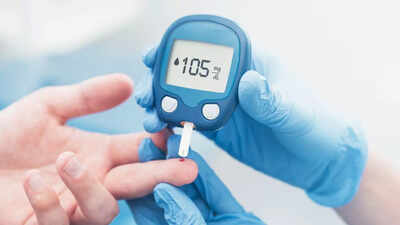For individuals managing diabetes, maintaining stable blood sugar levels is a continuous effort. A frequent challenge is the unexpected rise in blood glucose upon waking, often attributed to the "Dawn Phenomenon". This article explores the nature of this phenomenon and strategies to mitigate its effects.
Accurate morning glucose measurement is key to customizing management strategies, including medication adjustments, dietary changes, and lifestyle modifications. By understanding your body's unique responses, you can effectively address high blood sugar levels. A proactive approach to diabetes management leads to better blood sugar control and improved overall health.

Image: Conceptual image illustrating the dawn.
Blood sugar, or blood glucose, refers to the amount of glucose in the blood. Glucose is a sugar that serves as the body's primary energy source. The Dawn Phenomenon is a natural increase in blood sugar levels that occurs in the early morning, driven by the release of hormones like cortisol and growth hormone.
This phenomenon is common among individuals with diabetes, affecting over 50% of those with Type 1 or Type 2 diabetes. Monitoring blood sugar levels in the morning is crucial for informed decision-making regarding medication, diet, and lifestyle.
The American Diabetes Association identifies decreased insulin activity as a primary cause of high morning blood sugar. Between 3 am and 8 am, the body releases hormones that stimulate the liver to produce more glucose.
In individuals with diabetes:
These factors contribute to elevated blood sugar levels in the morning.
The main symptom of the Dawn Phenomenon is elevated blood sugar levels in the morning, typically identified through glucometer readings or continuous glucose monitoring devices (CGM).
Other common symptoms include:
Continuous glucose monitoring (CGM) is the most effective way to detect the Dawn Phenomenon. CGMs track glucose levels continuously, providing a detailed view of blood sugar patterns. If a CGM is not available, healthcare providers can analyze consistent glucometer readings to identify patterns suggestive of the Dawn Phenomenon. This analysis helps to:
Unmanaged Dawn Phenomenon can lead to consistently high blood sugar levels, increasing the risk of diabetes-related complications such as:
Addressing the Dawn Phenomenon is essential for preventing prolonged periods of high blood sugar and safeguarding long-term health.
The following lifestyle adjustments and home remedies may help lower morning blood sugar levels:
If you experience high blood glucose levels frequently, consult a healthcare professional. Always seek personalized advice from your doctor before trying new remedies or altering your medication.
The timing of blood sugar tests is important, as levels fluctuate after carbohydrate consumption. Recommended times for testing include:
To manage blood sugar spikes associated with the Dawn Phenomenon, consider the following strategies:
If elevated morning blood sugar levels persist, seek individualized advice from your healthcare provider. Consistency and regular follow-up can significantly reduce the risk of complications associated with the Dawn Phenomenon.
Newer articles
Older articles
 Rishabh Pant: Greg Chappell Hails India Star as Cricket Revolutionary
Rishabh Pant: Greg Chappell Hails India Star as Cricket Revolutionary
 Google Maps to Boost Navigation Accuracy with Fused Orientation Provider API
Google Maps to Boost Navigation Accuracy with Fused Orientation Provider API
 Gavaskar Calls for Kuldeep Yadav's Inclusion in Second Test Amid Bumrah Fitness Concerns
Gavaskar Calls for Kuldeep Yadav's Inclusion in Second Test Amid Bumrah Fitness Concerns
 Global Vaccination Rates Plunge: Millions of Children Now Vulnerable to Preventable Diseases
Global Vaccination Rates Plunge: Millions of Children Now Vulnerable to Preventable Diseases
 Skin Cancer Alert: How to Identify Suspicious Moles and Early Warning Signs
Skin Cancer Alert: How to Identify Suspicious Moles and Early Warning Signs
 Suryakumar Yadav's Sports Hernia: Understanding the Injury, Recovery, and Risk Factors for Athletes
Suryakumar Yadav's Sports Hernia: Understanding the Injury, Recovery, and Risk Factors for Athletes
 Ashada Gupt Navratri 2025: Unveiling the Hidden Significance, Dates, and Rituals of the Monsoon Festival
Ashada Gupt Navratri 2025: Unveiling the Hidden Significance, Dates, and Rituals of the Monsoon Festival
 IRCTC Launches AI Chatbot for Seamless Train Ticket Booking, Refunds, and Information Access
IRCTC Launches AI Chatbot for Seamless Train Ticket Booking, Refunds, and Information Access
 TSMC Regains Top 10 Global Company Ranking Amid AI Chip Demand Surge
TSMC Regains Top 10 Global Company Ranking Amid AI Chip Demand Surge
 Vijay Sethupathi Apologizes Amid Controversy Over Son Surya's Debut Film 'Phoenix' and Alleged Video Removal Pressure
Vijay Sethupathi Apologizes Amid Controversy Over Son Surya's Debut Film 'Phoenix' and Alleged Video Removal Pressure